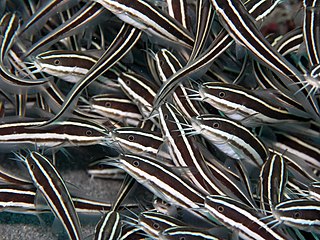
The rainbowfish are a family, Melanotaeniidae, of small, colourful, freshwater fish found in northern and eastern Australia, New Guinea, Sulawesi and Madagascar.

The eel-tailed catfish, Tandanus tandanus, is a species of catfish of the family Plotosidae. This fish is also known as dewfish, freshwater catfish, jewfish, and tandan.

Tandanus is a genus of eeltail catfishes endemic to Australia.
Oloplotosus is a genus of eeltail catfishes endemic to the island of New Guinea.
Porochilus is a genus of eeltail catfishes native to Australia and New Guinea.

Plotosus is a genus of eeltail catfishes native to the Indian Ocean, the western Pacific Ocean and New Guinea.
Cinetodus is a genus of sea catfishes of the family Ariidae. These species originate from brackish and fresh waters of Irian Jaya, southern New Guinea and northern Australia.
Microsynodontis armatus is a species of upside-down catfish endemic to Gabon where it occurs in the Ivindo River. It was first described in 2004 by Ng Heok Hee.
Microsynodontis hirsuta is a species of upside-down catfish endemic to Gabon where it occurs in the Ntem River. It was first described in 2004 by Ng Heok Hee.
Microsynodontis laevigata is a species of upside-down catfish endemic to Gabon where it is found in the Ivindo River. It was first described in 2004 by Ng Heok Hee.
Microsynodontis vigilis is a species of upside-down catfish endemic to Gabon where it occurs in the Ogowe River. It was first described in 2004 by Ng Heok Hee.
Neosilurus hyrtlii, commonly known as Hyrtl's catfish or Glencoe tandan, is a species of catfish found across northern Australia, from the Pilbara to southeastern Queensland.
Neosilurus brevidorsalis, commonly known as shortfin tandan or shortfin catfish, is a species of catfish native to lakes, swamps and rivers in northern Australia and New Guinea. It reaches a length of 20 cm (8 in).
Neosilurus gloveri, commonly known as Dalhousie catfish, is a species of catfish native to Dalhousie Springs in central Australia.
Neosilurus mollespiculum, commonly known as softspine catfish, is a species of catfish native to the Burdekin River system in Australia.
Neosilurus pseudospinosus, commonly known as falsespine catfish, is a species of catfish native to northwestern Australia.

Neoarius graeffei, or blue salmon catfish, is a species of catfish found in freshwater rivers of Australia and Papua New Guinea. This species is most identifiable by its large, shark-like dorsal fin that is led by a poisonous spine. Like other catfish, the blue salmon catfish is known to use electrical pulses to sense prey in the water. This prey sensing mechanism may be the reason that these catfish are known to eat the land dwelling hopping mouse at a high rate.
The comb-spined catfish is a species of catfish in the family Ariidae. It was described by Max Carl Wilhelm Weber in 1913, originally under the genus Arius. It is known to inhabit freshwater rivers in New Guinea. It reaches a standard length of 40 cm (16 in). Its diet includes prawns, detritus, and a variety of terrestrial and aquatic insects and insect larvae.
Neosilurus novaeguineae is a freshwater eeltail catfish described by Max Weber in 1907. It is endemic to New Guinea and occurs in both Indonesian and Papua New Guinean parts of the island. Common name New Guinea tandan has been proposed for it.
Neosilurus equinus, the southern tandan, is a species of fish in the eeltail catfish family. It occurs in streams in Papua and Papua New Guinea. It can be found in Lake Kutubu.




